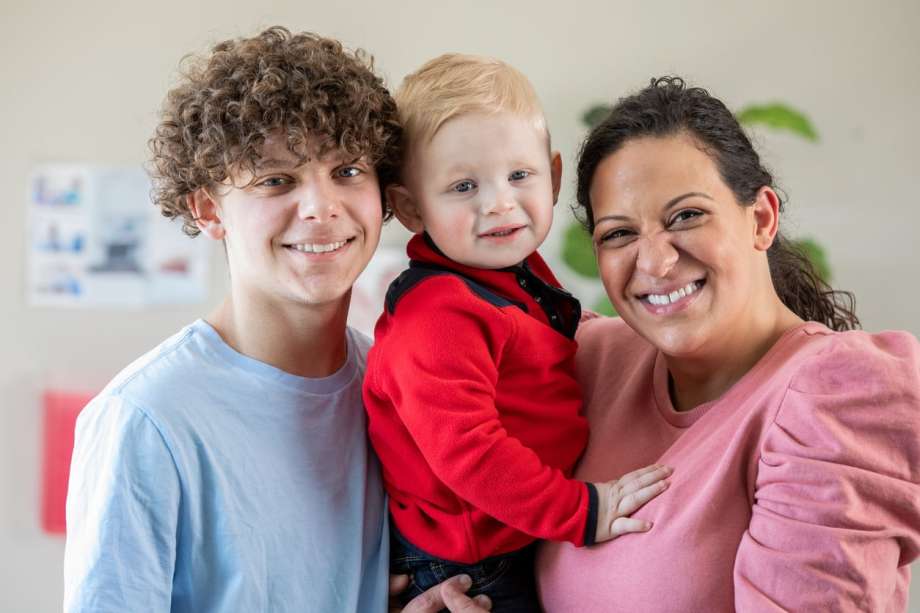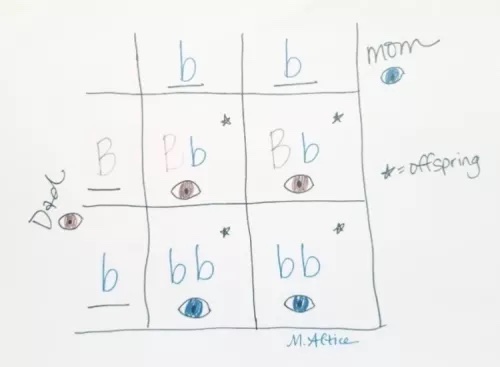My Baby Looks Nothing Like Me: A Genetic Explanation

Throughout pregnancy, parents excitedly imagine how their future son or daughter will look and what features and traits their baby will inherit from mom and dad.
Will she be tall like her father’s side or have blonde hair like Mom and her siblings?
Excitement builds as the time approaches to lay eyes on your mini-me…until your baby is born, and you notice, “My baby looks nothing like me!”
If your son or daughter looks nothing like either parent, don’t get paranoid that your child was switched at birth. The culprit is most likely genetics.
Let’s explore some of the most common genetic reasons why you may think you don’t share any physical traits or strong resemblance with your son or daughter.
Related: 6 Traits Babies Inherit From Their Father
How Genetic Traits Are Passed Down From Mom and Dad
Although genetics has a hand in turning the baby into a mini-me, the same players also morph him into a mini-not-me.
The creation of a human body goes far beyond simple building blocks. For around nine months, DNA from both parents comes together to create a unique individual. During that time, parents anticipate how the baby will look.
Many people believe that if both parents have brown eyes, their children will have brown eyes. Or, if one parent has black hair and the other blonde, the child will have one or the other.
But what happens when the child of brown-eyed parents has blue eyes, or the parents with dark hair produce a fiery red-head?
Dana Bressette, a genetics specialist and FamilyEducation expert, explains that genetics doesn’t really guarantee that we will share features with our offspring. This is because of the nature of genetics and the different players in court.
Our physical traits mostly rely on inheritance, which is the process by which genetic information is passed from parent to offspring. Inheritance is the reason why family members have similar features and characteristics.
“The genes for traits are coded onto our chromosomes,” Bressette says. “You get one from mom and one from dad for each of the 23 chromosomal pairs. Some traits like hair color and eye color are polygenic, meaning that they aren’t just controlled by one gene, but by many genes (poly = many). This is why there’s lots of variability in traits like hair color, eye color, or height.”

The Role Recessive Genes vs Dominant Genes in Appearance
Most genes come in two versions (alleles) - recessive and dominant. Dominant versions are more influential than their recessive counterparts and control a large portion of how your baby looks. But, as with anything in science, it’s more complicated than that.
Using Punnett Squares to Understand the Odds
To understand all the possible odds of inheriting different traits, biologists and geneticists use diagrams called Punnett Squares to explain patterns of inheritance.
Only a few traits are inherited as single genes, called monohybrid inheritance, including some genetic diseases but we can simplify things to include other physical traits like hair and eye color, skin tone, and facial features.
Will Your Baby Have the Same Hair Color as Their Parents?
The Punnett squares can be extremely advanced with numerous boxes, or as simple as a four-boxed diagram predicting eye or hair color for each offspring. The capital letter denotes a dominant allele, and the lowercase letter indicates a recessive allele.
Most people with red hair have two copies of a recessive red hair allele. Let’s consider a family who had a daughter with red hair when neither of the parents has red hair. My Punnett square shows the big R as the dominant allele, and the little r is the red-head recessive allele.
Both parents have a sneaky recessive allele for red hair floating around in their genetic make-up, so they have a 1 in 4 or 25% chance of having a child who ends up with two copies of the recessive allele, rr, and is the grand prize winner of red hair.
Can Babies Have a Different Eye Color Than Their Parents?
Even though there are two major eye color genes, more than 14 other genes could affect a person's eye color. Phenotypes (observable physical features such as eye color) are produced by certain genotypes (gene variants).
Eye color has a complex inheritance pattern but put simply, we can consider the brown eye allele to be dominant. This means that even if only have one copy of this allele, inherited from one parent, you will have brown eyes.
Parents with brown eyes can have a child with blue eyes if they both carry the recessive blue allele of the eye color gene. Recessive alleles keep things very interesting because they can be hidden in a person’s genome, only being expressed if they have two copies.
This means that if blue eyes are somewhere in the family tree of both parents, then there is a chance that both parents can be carriers of this allele and both pass them to little one, who will end up surprising them by having blue eyes.
However, it’s difficult to predict what color eyes baby will have based on Mom and Dad’s eyes because eye color is polygenic Children can inherit multiple physical traits from both Mom and Dad’s side of the family.
For example, little one could end up with your Mother’s eye color, your Father’s hair color or your Mother-in-law’s skin tone.
Punnett Square for Eye Colors

This image shows a Punnett square with a mother who has two recessive blue eye alleles so has the genotype bb and a father with one dominant brown allele and one recessive blue - who is Bb. They have a 50/50 chance of having a baby with blue or brown eyes.
“If you look at the Punnett squares for eye color,” says Bressette, “you can see how parents with brown eyes can still have a child with blue eyes. There was no switching at birth - it’s completely possible!”
How Environmental Factors Affect Appearance
Another thing to consider beyond genetics is environmental factors and how they affect appearance.. Our lifestyles and the choices we make influence our appearance, but in the vast majority of cases these traits will not be passed down to our children.
Changes to Physical Appearance Later in Life
Consider a father who works outside most of his life. His skin may take on a darker tone from consistent UV rays, but the genes his children will inherit are for his naturally pale skin, not the olive skin he got as a result of his work.
If your mother or father has gotten cosmetic surgery like a nose job, or if they dye their hair a different shade than it’s natural color, their children obviously won’t take on these altered physical features.
Pregnancy Diet and Nutrition
The mother's diet and health during pregnancy can also affect the baby's features, mostly in height and weight. Premature birth, diseases, poor nutrition, and environmental toxins could also cause differences.
As your child grows up, the environment that surrounds them will influence more than just their looks. The way you teach and guide them will mean they share certain life values with you, maybe even interests that you can enjoy together.
Perception and Affirmation Bias
The mind is a powerful force and may influence how much you believe your baby looks like you or your partner.
Rhythm of Birth owner and FamilyEducation maternity expert Shalene Massie suggests, “Each family member wants and hopes the baby looks like their side of the family.
A family member might imagine that the baby looks like their side of the family, leading the parent [from the other side] to believe it looks nothing like him or her. Those comments from family or friends may actually shift the psychological view and perception of the looks of the baby.”
Amazingly, the fact that our perception of who our baby looks like can be influenced by others is backed up by science. A research study found that Dads start to think that their baby looks more like them the longer they spend with them. (Volk et al 2010).
It seems that getting to know their baby’s facial cues more intimately can change how Dad perceives his child.
Do New Babies Look More Like Dad or Mom?
Scientists used to believe fathers were biased to think that their children looked more like them than they actually did. This makes sense from an evolutionary standpoint, as men in ancient societies wanted to make sure that their genes were successfully passed on.
However, more recent studies have shown that this is not the case, children are more likely to resemble both parents equally, which is what genetics suggests. (Bressan & Grassi 2004)
What To Do If Your Baby Looks Nothing Like You
It may certainly be disappointing if you were expecting your baby to be the spitting image of you but you just can’t see any resemblance at all, but consider the many reasons why this could be.
Remember Babies Looks Change Over Time
First of all, babies change a lot in their physical appearance during their first year of life and beyond. Your baby girl or boy’s facial features will change as they develop, eye color may change and hair will grow.
As your child gets older, more and more genes will start to activate. This is especially true when hormones kick in, and then bone structure begins to really develop when they reach their 20’s. Many facial features won’t be fully revealed until adulthood.
Don’t Try to Make Your Baby a Carbon Copy of Mom or Dad
It’s important to take a step back and give newborn babies a chance to begin forming a new identity as their own person. Unless there is an actual reason to do a paternity test to determine biological parents, no one should stress about their baby looking different from them!
As your baby grows into a child you might also start to notice they share certain mannerisms and personality traits with you rather than physical traits. These similarities are beautiful reminders of how parents shape their child’s life and personality long after they’re born.

